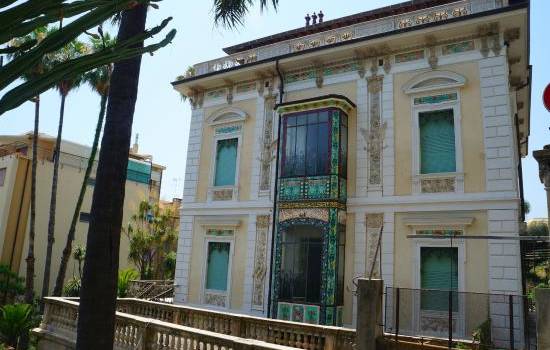Villa Angerer, ex Villa Feraldi, in 1882 was purchased, for a winter stay by the Austrian Leopold Angerer, lawyer from Innsbruck, a wealthy and eclectic man: scientist, bibliophile, travel lover. Angerer began the works that led to change the original appearance of the Villa from its original Renaissance style to a splendid example of the Art Nouveau style, whose value and charm are proportional to the fineness of the decorative apparatuses: stained glasses, ceramic coatings , irons and enamels that make up a set of flowers in a profusion of colour. A floor was added for the library, the terraces were closed by bow windows with floral windows, stucco and majolica decorations and animal-shaped railings, terracotta chimney pots with dragons and flowers were added.
After years of neglect, looting and decay, a partial dignity was returned to this place through work that involved the recovery of the garden and the securing of the access cave. The villa was therefore partially restored after years of neglect, during which the structure suffered numerous structural damages. For example, during the War, the iron decorations of the fences were removed and melted for war purposes and unfortunately a decorative vase at the entrance of the villa was destroyed by a truck of the restructuring company that accidentally bumped into it.
THE GARDEN
The theme areas of the park are two: the first one, in front of the Casino, in which there are succulent plants, palms and succulents from Central America, among which two monumental plants of nolina recurvata stand out. The second area reproduces a subtropical setting with exotic plants of the five continents, some of the hot-humid area like the impressive cycadaceae. Together with the numerous rare and monumental botanical species there are two “caves”: the Cave of Mirrors and the Cave of the Dragon. The first was a small cave whose mirrored walls gave the illusion of more space. Inside, a waterfall from a statue, emerged to form a small pond. Now, unfortunately, after years of decay only the feet of the statue are left inside the cave.
The Cave of the Dragon, instead, is found at the end of the boundary wall and is in fake oriental style, with walls in fake rock and an all-round iron gate, which imitates a weaving of branches and ropes. Inside there is a statue of a dragon.
In the garden of the villa there was also an experimental greenhouse, now destroyed; the famous botanist, Mario Calvino, father of the famous writer Italo Calvino, worked in it.
A turret, built in bricks that Angerer brought back from the places he visited on his travels, is still preserved with their provenance engraved. After the 2014 renovation works, the inside of the caves and the walk along Asquasciati Street wall have been cleaned up and made safe.
The heart of the garden is a very rare and very ancient plant whose presence in nature is estimated at just under a hundred specimens.: the Wollemia Nobilis. The Wollemia, whose fossils dates back to 90 million years ago and had been believed to be extinct for two million years, is recognized as a living fossil due to its unchanged genetic characteristics: fossil finds from the Jurassic period in fact reproduce twigs and leaves superimposable on today’s plants.
To emphasize the age of this plant, surrounded by a protective fence, some graphic representations of prehistoric animals have been added in the park, to create a didactic symbolism between the evolution of the animal and plant worlds and to show the great transformations that have accompanied the evolutionary process.

